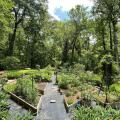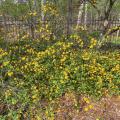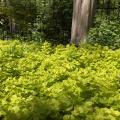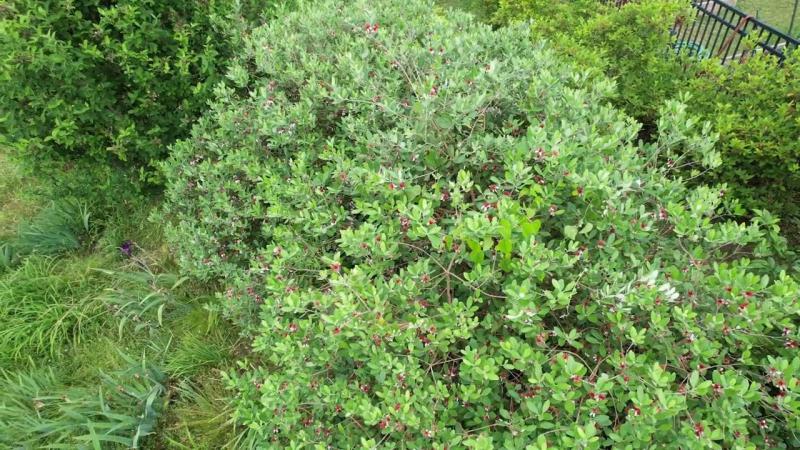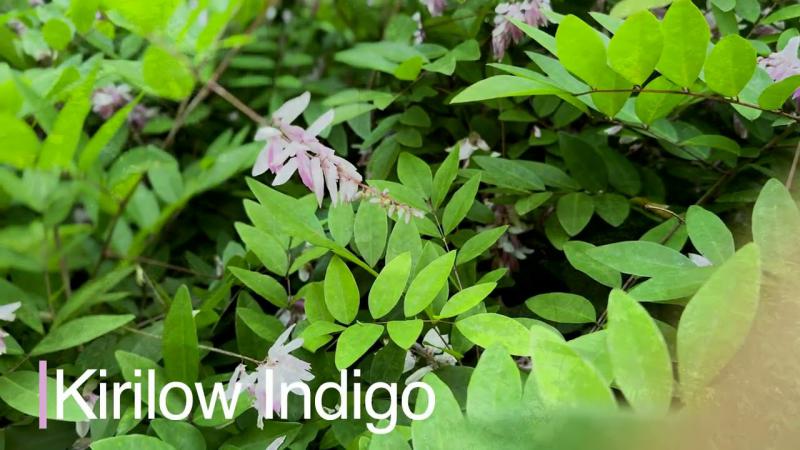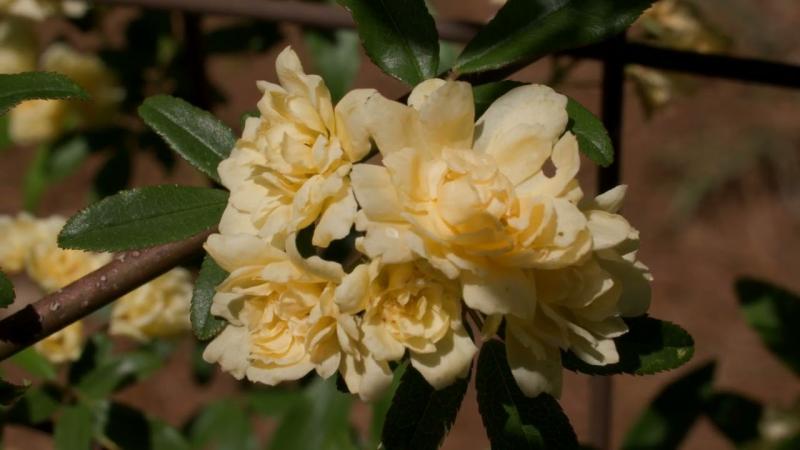Techniques and Tips for Growing Good Roses
Roses sometimes have a reputation for being fussy and time-consuming to maintain. Much depends on the type of rose grown. However, any rose will respond positively to good care. Let’s look at several ways to maintain good growth in roses and make those little chores easier to handle. We will look at fertilization, mulching, and watering techniques in this presentation.
Let us remember that part of the joy of roses is getting to work with them and watch them respond to our attention. They can be your pets of the plant world, if that is what you want them to be. Or your roses can be a part of the overall landscape and survive on whatever environmental conditions they encounter. It all depends on what your objective is for that plant in your garden.
Good soils make fertilization and watering easier.
- Sandy soils do not hold onto nutrients or water as tightly as loam or clay soils.
- Clay soils hold onto nutrients and water more tightly, but they may require more effort to balance pH or provide drainage than loam or sandy soils.
- Loam soils with a good balance of sand, clay, and organic matter are crumbly and help provide for nutrient and water retention as well as porosity for oxygen and root penetration.
Fertilization
- Periodic soil tests provide information to make good fertilization choices.
- Ideal – pH 6-6.5
- Nutrients become less available as the pH becomes strongly acidic, pH 5.0 or less
- Nutrients become less available as the pH becomes greater than 6.5, especially Phosphorous, Magnesium, Iron, Manganese, Boron, and Zinc
- Add lime in the fall, winter, or early spring to increase pH. Allow time for the change to take place
- Use dolomitic limestone if the soil is low in magnesium.
- Use calcitic limestone if the soil is high in magnesium.
- Fertilizers containing sulphur will tend to lower the pH. – ex. Ammonium Sulfate, Iron Sulfate, Aluminum Sulfate, Soil Sulfur
- Ideal – pH 6-6.5
- Basic elements
- Carbon
- Hydrogen
- Oxygen
- Major essential elements
- Nitrogen – Stimulates growth, leaves become pale green to yellow with too little Nitrogen, excess Nitrogen causes weak stem growth, reduced flowering, reduced disease resistance
- Phosphorus – Stimulates good root growth and better flowering, promotes plant maturity and hardiness
- Potassium – Supports root growth, vigor and bloom color
- Minor essential elements (Micronutrients)
- Sulfur
- Calcium
- Magnesium
- Iron
- Zinc
- Manganese
- Copper
- Boron
- Molybdenum
- Chemical fertilizers
- Provide the basic nutrients needed but do not improve the condition of the soil
- Formulas are often high in available nutrients, so care must be taken to apply at the correct rate and placement to avoid burning the plant.
- Quick release forms - potential for burn if applied inappropriately
- Quick release forms may be granular or liquid.
- Liquid forms are often used for fertilizing pot plants or where proportioners are used for ease of application.
- Liquid formulas are often used when dilute solutions are desired with each watering.
- Slow release forms – breakdown over time, less potential for burn
- Forms that dissolve slowly or require bacterial action – Sulfur coated urea
- Forms that are coated with resins that slow down the rate of release - rated for 3 months, or 9 months, etc.
- Slow release forms are generally in granular form because of their coatings.
- Single element fertilizers
- Ammonium Nitrate (34-0-0), Urea (46-0-0)
- Super Phosphate (0-20-0), Triple Super Phosphate (0-46-0)
- Muriate of Potash (0-0-60)
- Complete fertilizers (N-P-K) – 5-10-5, specialty branded fertilizer mixes that are developed specifically for roses
- Balanced fertilizers (N-P-K) – 13-13-13, 20-20-20
- Organic fertilizers, nutrients derived from once-living organisms
- Formulas are usually low in available nutrients and may contain organic matter that is suitable for improving soil structural properties. Contents of organic fertilizers may vary greatly from
- one lot to another, and how they are composted prior to use.
- Organic fertilizers are broken down by soil microorganisms and are therefore more effective when moisture is present and temperatures are high enough for abundant microbial activity.
- Cottonseed meal – acidifying, can be used to lower pH in a high pH soil.
- Blood meal – Dried, powdered blood from cattle slaughterhouse sources. High in Nitrogen, a source of iron and some essential micronutrients.
- Alfalfa meal – Organic soil additive, can be incorporated into the soil or used as a “tea”, a liquid derived from soaking the alfalfa meal in water for a period of time.
- Fish emulsion – Partly decomposed finely pulverized fish, high in Nitrogen and contains some micronutrient elements, can burn plants if applied in too strong a solution
- Manures – Levels of nutrients vary according to the animal from which the manure is derived, how the animal was fed, and how the material is composted. The level of nutrients is generally low, but the material can be a good source of organic material for soil amendment purposes. Fresh manure should be avoided as it can burn tender plant roots and may harbor microorganisms that are harmful to humans. Proper composting techniques are important to reduce such risks.
- Cow
- Horse
- Poultry
- Sheep
- Sewer Sludge – Treated sludge from municipal sewage treatment plants, activated sludge is in dry granular form, heavy metals may be present.
- Salts and their capacity for plant injury
- Soils may be naturally high in salts, especially near coastal or estuary environments, or in certain soils and require special handling.
- Heavy fertilization can increase salts levels to the point of causing root burn. Liberal applications of water to dilute the salts and carry them away from the root systems may be required to reduce physiological drought.
- Drip irrigation may increase salt concentrations in their zones of water infiltration over time if the water contains high levels of salts. A watering system that delivers more water at one time may be needed in such a case.
Mulching
- Mulching insulates the soil surface around plants or within rose beds
- Protects from heat in summer and freezing in winter
- Reduces water loss from evaporation or erosion
- Reduces splashing of soil onto foliage, reducing spread of infectious agents, and presenting a clean and neat appearance of the plant
- Adds nutrients to soil as it breaks down
- Improves soil texture also as it breaks down and is incorporated into the upper levels of the soil by microbial action and tunneling of small creatures
- Types of organic mulch
- Pine straw
- Pine bark, shredded, chunk
- Pecan shells
- Rice hulls
- Cocoa shells
- Leaves
- Compost
- Compost, great way to improve soil and use local “free” material
- Black gold when done right, obnoxious when done wrong
- Simplest form is to pile leaves, healthy garden trimmings, grass clippings, vegetative kitchen scraps in corner of yard that is out of the way, but accessible with garden equipment
- Avoid animal wastes or bones, weeds, diseased plant parts
- Chop large material if you want faster breakdown
- Moisten to start microbial action
- Turn often to get uniform distribution, provide good aeration, and maintain even moisture
- Allow the microbial mass to act on the compost pile, will get varying degrees of heat, depending on how the mass is maintained
- Bins – size according to the equipment you use, the space you have, or how neat it needs to be
- Circle of wire fencing
- Wood slatted bin
- Series of wood slatted bins, usually three
- Prefabricated units
- Organic materials that can be added to improve soil structure, some benefit by further composting and the addition of Nitrogen
- Ground corncobs
- Sawdust
- Woodchips
- Leaves
- Straw
- Hay
- Peat moss
- Compost
- Lawn clippings
Watering
- Water newly planted rose thoroughly when planted
- Provide even moisture, especially when plant is establishing a new root system
- Avoid overhead watering to reduce disease pressure
- Consider subirrigation system
- Soaker hose
- Bubblers
- Drip system
- Can use house water system, with or without timer
- Can use separate irrigation metered system as part of overall garden irrigation system, usually with controller
Resources and selected websites:
- The American Rose Society Consulting Rosarian Reference Manual, 1st Ed. 1995. The American Rose Society: Shreveport, LA.
- Brady, Nyle C. and Ray R. Weil. 1999. The Nature and Properties of Soils, 12th Ed. Prentice Hall: Upper Saddle River, NJ.
- Rainbird Corporation - http://www.rainbird.com
- The Toro Company - http://www.toro.com
- Hunter Industries Incorporated - http://www.hunterindustries.com
- Maxijet, Inc. - http://www.maxijet.com
- Netafim USA - http://www.netafim-usa.com
Additional Reading Selections:
- Cruso, Thalassa. 1971. Making Things Grow Outdoors. Alfred A. Knopf, Inc.: New York, NY.
- Melby, Pete. 1988. Simplified Irrigation Design. PDA Publishers Corporation: Mesa, AZ.
- The Memphis Garden Club, Ed. 1984. The Mid-South Garden Guide, Rev. The Memphis Garden Club: Memphis, TN.
- Watkins, James. 1987. Turf Irrigation Manual: The Complete Guide to Turf and Landscape Sprinkler Systems.
-- By Pam Collins
Publications
News
The peaceful backyard garden of Beattie Williams in Vicksburg, Mississippi, is a master class in the use of raised beds in a home landscape.
Yellow-blooming plants bring a bright, cheerful energy to my garden. There’s something about that bold splash of golden color that lifts the spirit and catches the eye, especially after the gray tones of winter.
In Grenada, Mississippi, Devo and Rosemary Lancaster have a couple of showstopping yellow bloomers in their landscape.
While visiting the home of Devo and Rosemary Lancaster in Grenada, Mississippi, I was impressed by their creative use of ground cover plants throughout the landscape.


